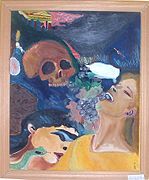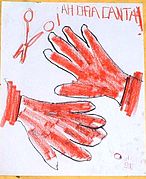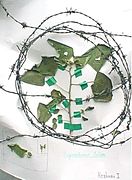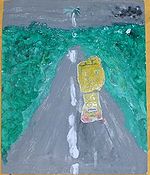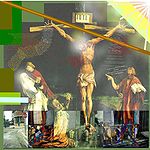- Norbert-Bertrand Barbe
-
Norbert-Bertrand Barbe is a French art historian, semiologist, artist and writer, born in 1968. He has a Master's degree in art history (Université Paris X, 1991) and Ph.d. in Comparative Literature (Université d'Orléans, 1996).
Contents
Acknowledgements
- 1995: Prize Arts and Letters of France in Novel section (for Poor Mr. Snow) and Essay section (for "Patrick McGoohan's The Prisoner: From the Self to the Beeing - An essay of objective interpretation").
- 2007: Ana Santos Rios, The poetic and pictorial works of Norbert-Bertrand Barbe, thesis in Hispanic Literature, Catholic University, Managua
- 2009: The Nicaraguan Center for Writers Nicaraguan Writers Center awarded a recognition by delivering a plaque for his career as a writer
 French art historian Norbert-Bertrand Barbe at a reception in his honor in January 2009 at the American University in Managua. From left to right: Dr. Carlos Tunnermann-Bernheim, President of the Nicaraguan Center of Writers (CNE) and Dr. Norbert-Bertrand Barbe. In the background (white): the poet Father Ernesto Cardenal, honorary President of the CNE.
French art historian Norbert-Bertrand Barbe at a reception in his honor in January 2009 at the American University in Managua. From left to right: Dr. Carlos Tunnermann-Bernheim, President of the Nicaraguan Center of Writers (CNE) and Dr. Norbert-Bertrand Barbe. In the background (white): the poet Father Ernesto Cardenal, honorary President of the CNE.
Biography
He worked as a teacher and researcher since 1992 in several French, Costa Rican and Nicaraguan institutions.
His fields of relevance are, chronologically, the Middle Ages, modern times and the contemporary era]. Geographically, Europe and Americas, in particular Latin America, with special emphasis on Nicaragua. At the level of theoretical fields and their objects, he dedicated himself to the study of symbolic productions (plastic arts, literature, cinema, myths) and the methodological and epistemological rationalization of its approach.
He developed this approach from his doctoral thesis The themes of the Raft of the Medusa by Théodore Géricault studied through their recurrence in the work of the painter, and art and literature of the 19th century (1992) and Roland Barthes and the aesthetic theory (1996), to his book Arturo Andrés Roig and the epistemological problem (1998). He is the author of more than 1200 articles.)[1] published in national print media and magazines (France, Spain, United States, Mexico, Nicaragua), and on internet (Spain, Colombia, Mexico, Venezuela, Puerto Rico, Costa Rica).
As editor, he published more than two hundred books,[2] more than fifty such as author, and about ten as a translator. So he is the first and only translator and editor to the French of the major classics of Nicaraguan literature, like Salomón de la Selva, Alfonso Cortés, Ernesto Cardenal and Carlos Martinez Rivas.
The theoretical books by Norbert-Bertrand Barbe are accessible on the main University libraries around the world (Yale, Princeton, Emory, Harvard, Oxford, Heidelberg, La Sorbonne, Tokyo, Kyoto, etc., as well as in the Library of Congress or in the National Library of Sweden).[3]
Among these texts are, in addition to the already mentioned texts: Darian Studies (2001), Latin American studies (2004), Bosch Bruegel (2004), Two attempts to understand advertising today (2004) A roll of the dice will never abolish chance or Stéphane Mallarmé and the question of abstract art (2004), Europe and Latin America Meeting Dialogues (2007).
Published in 2001, his thesis on Barthes provided a framework to a set of 4 books, contemporary groups, which sought to study systematically the symbolic productions from the comparatist and panoskian principles raised in it: 1 / Iconologia and the ArteFactos in Managua (2001, 2005) in the plastic arts, respectively of Europe from the romanesque Crucifixion to surrealism and abstract art in the Nicaragua of the 1990s; 2 / Literary origins of contemporary thought (2001, 2007) with regard to European and American literary material from the 18th century; 3 / Myths (2001, 2004), on indo-european, medieval European and American mythologies of the origin; 4 / Essays on filmic iconology and Shall We Talk About Cinema (2001, 2005), about cinema and advertising.
In addition to his articles on literature and Latin American philosophy, published in La Prensa and El Nuevo Diario (1997–2007), Barbe participated notably in the nicaraguayan press, with two columns, respectively, weekly and bi-monthly, published in El Nuevo Diario: Shall We Talk About Cinema (1997–1999) and in the cultural sabbatine supplement Nuevo Amanecer Cultural: Culture Lodge (2005–2008) on concepts (such as dirt, childhood, movement), art and literature of the 18th - 21st.
Barbe textbooks have been commented on in national media and magazines specialized in France and England. They served as a basis for thesis in La Sorbonne and in Nicaragua in the Catholic University UNICA.
Barbe was also the organizer of the I International Congress on Panosfky (France, 2003), and the editor of the Acts proceeding of the Congress (2004).Artistic orientation and theoric relevance
In poetry and art, his work has evolved from a naturalistic expressionism to decomposition formal and narrative questions, particularly through the shocker pop and photomontages.
In the 2000s he developed “processal” works and “geometric poems and tales”,[4] which incorporate the concept of “Not Happening” and “reverse literature” in which the structure of the narrative construction appears to the reader/viewer.[5] He is co-founder of the movement Kites (1996–1999) and Any Name (1998–2005), founder of the journal Go Home (2005 to date) and founder of Bes editions (2001 to date).
As a theorist, his path is defined by its interdisciplinarity (Masters in Low Medieval Art History; DEA and Ph.D. in Comparative Literature, respectively modern and contemporary, his Ph.D. touching issues of aesthetic and epistemological study of the works).
The main contributions of Norbert Berttand Barbe in the Humanities studies are:
1/ The unification of a general theory of interpretation of symbolic productions[6] through his books Iconologia (about visual arts), Myths (about mythology), Literary origins of contemporary thought (about literature), Essays on filmic iconology (about films).
2/ Mirroring macro phenomena from micro (Nicaragua).[7]
3/ The comprehensive approach to the development and structural evolution of the modern mentality to the contemporary one studied in its works.[8] In books: Culture Lodge, The Construction of the Me; Literary origins of contemporary thought; Nothingness in contemporary thought; Darian Studies.
4 / The iconological approach to contemporary art and motifs as minimal units of meaning to assume the abstract work as a historical phenomenon readable since his time.[9] In books: Representation: Iconographic problem of contemporary art; Sur-realism; The Scream by Edvard Munch: A paradigmatic case of staging iconic codes of an era; Stéphane Mallarmé and the question of abstract art.
5 / The study of modern and contemporary architecture as an expression not just concrete and practical of using necessities, but also intellectual of formal tensions.[10] In books: Meaning and context of the Black square on White background by Kazimir Malevich: An testimonial and argumentative object of vanguards in their controversies with figurative art about issues of color and formal composition; A History of Modern Architecture 12th-18th centuries; History of contemporary architecture 19th-21th [sic?] centuries.
6 / The analysis of discourses of domination from the study of mass speech.[11] In books: Two essays on [[Laugh; Elements of the political construction of contemporary thought nineteenth-twentieth centuries - Criticism and lies: From Public School to Socialism of the [[21th century|21th [sic?] century]]; Vox Populi: Why we are not free; Metalanguage and dominance speeches in the postmodern culture and politics.Bibliography
Translator of: The Güegüence; The Unknown Soldier by Salomón de la Selva; Poetry, Afternoon Gold, Eleusinian Poems, The Doors of Pastime, The Universal Rhymes, The People's Verses, 30 Poems by Alfonso Cortes; Epigrams by Ernesto Cardenal; The Paradise Regained, The little girl turned to her death, The Lonely Insurrection, Varia, The way of the bat by Carlos Martínez Rivas; Pastor of the mistakes by Roberto Armijo; Torrent of Steel by Raul Orozco; Raging Orphan by Marta Leonor Gonzalez; The Plums I kept in the icebox by Hector Avellan.
Author of poetry books: Diane Games, L'Arma Jane Doe, Exquisite Corpses, Me Blessed Claude (aka Poems against the National Agency for Employment and Tropical Interlude), (A little more than) 20 poems of hatred and a desperate song, Tear me out of your heart my love, Nicaraguan Caprices, Microside of Myself, World Stage.
Poems and stories published in the following magazines: Poètes du Nord-Pas de Calais, Flammes Vives (France), Regarts (Belgium), Letras Salvajes (Puerto Rico), Club de Brian, Café Literario, Al margen.com (Mexico), Zona de Tolerancia (Colombia), Hispanic Culture Review (United States), Katharsis, La Botella Vacía, Ábaco (Spain), Arte Poética (El Salvador), Pluma Libre (Costa Rica); & in Nicaragua: ArteFacto, Estrago, Ojo de Papel, La Tribuna, El Nuevo Diario, La Prensa Literaria, Decenio, Papalotl (of which he was co-founder), Voces Nocturnas, From XTepetl, Gojón (these latter two of which he was the founder).
Author of books of short stories: Idiotic Tales 189..., Diary of anxiety on university campus.
Author of books on art theory and literature: Roland Barthes and the aesthetic theory; The themes of the Raft of the Medusa by Géricault studied through their recurrence in the work of the painter, and art and literature of the 19th century; The wounded cavalryman leaving fire and the patriotic apology in Géricault; "The group of painters from Saint-Jean-De-Mont and the regionalist literary movement of Vendée 1890-1940", Iconologia from Bosch and Bruegel to the surrealists; Los ArteFacto in Managua; Essays on filmic iconology; Shall We Talk About Cinema; Literary origins of contemporary thought nineteenth-twentieth centuries; Myths about the God of Fart; Darío Latin Americanist; Darian Studies; Borgian Studies; Latin American Studies; Iconologiae; Arturo Andrés Roig and the epistemological problem; Two essays on laugh; Two essays for understanding advertising today; A roll of the dice will never abolish chance or Stéphane Mallarmé and the question of abstract art; Hitchcock; Europe and Latin America Meetings and Dialogues; A History of Modern Architecture 12th-18th centuries; History of contemporary architecture 19th-21st [sic?] centuries.
Illustrator of: The Washtub Farce, The strange disappearance of the hood of Santa Claus.
Columnist of: El Nuevo Diario, La Prensa Literaria, El Nuevo Amanecer Cultural (Nicaragua), Critique d’Art (France).
Creator of the columns Shall We Talk About Cinema (1997–1999) de El Nuevo Diario, Culture Lodge (2005–2006) de Nuevo Amanecer Cultural de El Nuevo Diario.Literary prizes
Prize Arts and Letters of France in novel and essay (1995).
He participated as guest poet at the Poetry International Festival of San Salvador (2006), Havana (2007) and Granada, Nicaragua (2005, 2006, 2007).Individual exhibitions
1987:Sceaux[disambiguation needed
 ], France
], France
1999: Sample/s on glass, UNAN-Managua, 2004:
No 5 of the internet magazine: http://web.archive.org/web/20091028052126/http://www.geocities.com/letrassalvajes/N5.html
No 3 of the Mexican internet magazine: www.clubdebrian.com
2005: Up To U, Añil Gallery, Managua.
2010: Rational Works, Casa de los Tres Mundos, Granada.Collective exhibitions
- 1998: Kites, Casa de los Tres Mundos, Granada and Managua
- 1999: García Ocón Barbe and Exhibition for blind people, ArteFactoría, Managua; Caraceños young artists, Convention Center, Jinotepe;
- 2006: Another Granada for Walker, Macondo, Rufino Garay Theatre Granada, Managua; Fusion, Casa de los Tres Mundos, Granada
- 2007: Author, coordinator and participant in Street-Art, under the hospice of the Institute of Culture, Managua, Revolution Square / Central Park / Area of the Institute and the Palace, from 11 November to 2 December; Fusion, Casa de los Tres Mundos, Granada
- 2008: Fusion, Granada, November–December; Bodies painted with imagery of Güegüence, exhibition work and body painting, House of Culture, Diriamba; Happenings "Nothing happens", VI Bienal de Artes Centroamericana, Managua
- 2009: Project Gaia - Ecological Havoc 2009, in the spaces: UCA Library, School of Dance "Open Space" Teatro Sala Justino Rufino Garay, XV Festival of Contemporary Dance-Theatre Room Victor Romeo, Managua; Fusion, Casa de los Tres Mundos, Granada, November–December
- 2010: Ecological Havoc, French and German Cooperation Alliance, February
Works conserved in the national collections of the Central Bank of Nicaragua and the Museum of Fontenay-le-Comte, France.
As a filmmaker and video artist:
- 2004 - Script, direction and editing the short movie Shepherdess; Production and publication of the audiovisual double CD Upside Down Cat; And editing the short animation filmAnd a nightingale flutters on my finger
- 2006: adaptation, written and directed the theatrical work Sex in León and Managua, on the basis of Sartre's No Exit.
- 2009: Do not Be Late, event for New Year, Zona Hippo, Managua
As an illustrator and publisher:
- Illustration of a classic piece of French medieval theater: The Washtub Farce, 2002.
- Another picture book: The strange disappearance of the hood of Santa Claus, children's picture book, 2004.
- Illustrator of poem book Mourn someone sees me in a dream by Francisco Ruiz Udiel, Not Anymore From XTepetl, No 4-5-7 triple, from August to December 2006.
- 2006-2010: creator, editor and designer of the magazine Gojón (previously known: From XTepetl; Not Anymore From XTepetl)
As curator:
- Creator and participant in Street-Art, February 28, 2006, in Managua.
- Participant and co-creator of the event Street-Art on the Calzada Street of Granada, October 27, 2006. In 2007, occurs the event Street Art (which, in 2006, was the origin of the momentum of the Museum of Contemporary Art and Design in Costa Rica to do eight events/artistic events on the street), parallel to the Central American Biennial, during the four weekends of November 10 to December 2 at the Plaza of the Revolution]] (atrium of the National Palace of Culture) and at the Central Park Rubén Darío in Managua, sponsored by the Institute (Ministry) of Culture. Street-Art, as the event becomes conceptual, repeating in 2008 and 2009 in the form of an internet invitation, with achievable goals individually and collectively over a week.
Major books and articles on the work of Norbert-Bertrand Barbe
- Claude Lepelley, Michel Sot, Pierre Riché, Haut Moyen-Age: culture, éducation et société, Université de Paris X: Nanterre, Centre de recherches sur l'Antiquité tardive et le haut Moyen Age, Publidix, 1990, p. 7.
- Letopis Matice srpske, Vol. 440-443, U Srpskoj narodnoj zadružnoj štampariji, 2001.
- Lire/Aimer, Connaître/Ecrire, Editer/Publier : du Rêve à la Réalité, in Un éditeur, un homme, Bulletin d'information et Relation L'Estracelle de la Maison de la Poésie Nord-Pas de Calais, N° 4, 2002, pp. 30–33.
- Mongi Madini, Deux mille ans de rire, Presses Universitaires de Franche-Comté, 2002, pp. 31–40.
- Jorge Eduardo Arellano, Voces indígenas y letras coloniales de Nicaragua y Centroamérica, Managua, PAVSA, 2002, p. 251.
- Agnès Lontrade, Roland Barthes et la théorie esthétique de Norbert-Bertrand Barbe, Critique d'Art, No 19, spring 2002, p. 40.
- El regreso del Papalote - Una entrevista de Porfirio García Romano con Norbert-Bertrand Barbe, El Nuevo Diario, 02/08/2002.
- Bruno Chenique, Les dix numéros de la Méduse, La Méduse, Bulletin Informatif de l’Association des Amis de Géricault, Paris, n° 11, september 2002, p. 1.
- Carlos Mántica, El habla nicaragüense, Managua, Hispamer, 2004, pp. 153–156.
- Livre Suisse, Nos 13-16, Schweizerischer Buchhändler- und Verlegerverein, 2004, pp. 2028, 2113.
- William J. Thompson, French XX Bibliography: A Bibliography for the Study of French Literature since 1885, Susquehanna University Press, 2004, vol. 55, p. 18098.
- Erick Aguirre, Las traiciones de Norbert-Bertrand Barbe, El Nuevo Diario, 01/10/2005, pp. 9–11.
- Luis Gonzalo Ferreyra, La Morale de l'émergence chez Arturo Andrés Roig, thesis under the direction of Patrice Vermeren, Paris VIII Vincennes/Saint-Denis, Department of Philosophy, 2005.
- Éric Peltier, Revues et magazines: guide des périodiques à l'intention des bibliothèques publiques, Paris, Editions du Cercle de La Librairie, 2006, pp. 176–189.
- Livres de France, Nos 297-298, Éditions professionelles du livre, 2006, pp. 6, 113, 148.
- Inés Izquierdo Miller, A Puerta Cerrada en la ciudad de León, La Prensa, 22/07/2006, p. 9B.
- Martin Mulligan, Calle Arte-Granada se toma Plaza de la Independencia, El Nuevo Diario, 7/11/2006.
- Ana Santos Ríos, La Obra poética y pictórica de Norbert-Bertrand Barbe, thesis in Hispanic Literature, Catholic University, Managua, 2007.
- Anales de Literatura hispanoamericana, Universidad Complutense de Madrid, Cátedra de Literatura Hispanoamericana, Vol. 32, 2007, p. 127.
- Sergio Ramírez, Tambor olvidado, Madrid, Aguilar, 2007, pp. 268–270.
- Rocío Oviedo Pérez de Toleda, Herencia y Centenarios. Noticias de Rubén Darío en el Nuevo Milenio, Anales de Literatura Hispanoamericana, 2007, Vol. 36, p. 127.
- Rebecca Arcía M., Celebran al mejor reportero, La Prensa, 23/01/2007.
- Jorge Eduardo Arellano, Hacia la momificación de Don Sal, El Nuevo Diario, 12/06/2007.
- En los recintos poéticos del Dr. Barbe, El Nuevo Diario, 19/07/2007.
- Arnulfo Argüello, Arte Contemporáneo, La Prensa Literaria, 17/11/2007.
- Adelina Morris, Un Coup de Dés : ou Stéphane Mallarmé et la question de l’art abstrait, Modern and Contemporary France, february 2008, vol. 16, No 1, pp. 76–77.
- Gill Allwood, Modern & Contemporary France, 1469-1869, The Journal of the Association for the Study of Modern & Contemporary France, Routledge Francis & Taylor Group, Volume 16, Issue 1, 2008, pp. 73–107.
- William J. Thompson, French XX Bibliography: A Bibliography for the Study of French Literature since 1885, Associated University Presse, 2008, vol. 59, p. 19795.
- Steven F. White, Esthela Calderón, Culture and customs of Nicaragua, Greenwood Press, 2008, pp. 171–172.
- Escritores distinguidos, La Prensa Literaria, 10/01/2009, p. 2.
- Francisco Ruiz Udiel, Fusión de artes visuales en Granada, El Nuevo Diario, 29/10/2009.
- Carlos Mántica, Escrudiñando El Güegüence, Managua, Hispamer, 2010, p. 7.
- Artiste Francais: Raymond Savignac, Norbert Bertrand Barbe, Lucien Begule, Henri Goetz, Jean Lurat, Liste Des Artistes Français, General Books, 2010.
- Jacques Halbbronn, Le livre blanc de l'astrologie, Paris, La Grande Conjonction, 2011, p. 106.
Visual art
Gallery of Norbert-Bertrand Barbe ''Adam and Eve'', oil on canvas, 1986''Tribute: Victor Jara'', drawing on paper, 1998''L'art en sort (Art emerges from here)'', gouache sobre papel, 1998''Military Regionalism'', collage on cardboard, 1998''Selfportrait as a Christ'', collage on cardboard, 1998''Selfportrait as a Young Donor'', gouache on cardboard, 1998''Nica Bus'', gouache on paper, 1999''The Self Washing Portrait'', gouache on paper, 1999'''But they did the 3 dwarves at the foot of the Cross?'' photomontage, 2002''No Way Out'', photomontage, 2003''Warf'', photomontage, 2003''Perfect Virgin'', photomontage, 2003''Maternity'', photomontage, 2007''Plastic Houses'', photomontage, 2008References
- ^ See: http://franzosisch-kunsthistoriker.blogspot.com
- ^ By editing and publishing, for instance, wide collections of Founder Texts from Antiquity to 20th century like on: Art, Cook, Our Politic Thought, Erotism Sex and Feelings 18th-20th centuries, 7 Founder Texts of the European Nations, The Nothing in the contemporary thought; & by editing and publishing Complete Works of: Abélard and Héloïse, Adam de la Halle, Agrippa d'Aubigné, Juan Bautista Alberdi, Apuleius, Archimedes, Pietro Aretino, Ludovico Ariosto, Aristophanes, Aristotle, Saint Augustine, Jane Austen, Balzac, Francis Beaumont & John Fletcher, Andrés Bello, Gonzalo de Berceo, Bernard de Clairvaux, Boccaccio, Martin de Braga, Saint Brendan, the Brontë family, Buffon, Robert Burns, Lord Byron, Catullus, Cavalcanti, Cervantes, Julius Caesar, Chaucer, Coleridge, Cyrano de Bergerac, Dante, Darwin, Descartes, Diderot, Dickens, Diodorus Siculus, Émile Durkheim, Emerson, Eschylus, Euclid, Euripides, Flavius Josephus, Flaubert, Saint Francis of Sales, Frontinus, Galileo, Gilbert & Sullivan, Goethe, Hesiod, Hippocrates, Hobbes, William Hogarth, Homer, Horace, Victor Hugo, Ingersoll[disambiguation needed
 ], Washington Irving, Saint John Chrysostom, Ben Jonson, Kant, Charles & Mary Lamb, Lorenzo de' Medici, Lautréamont, Lessing,[disambiguation needed
], Washington Irving, Saint John Chrysostom, Ben Jonson, Kant, Charles & Mary Lamb, Lorenzo de' Medici, Lautréamont, Lessing,[disambiguation needed  ] Locke, Lope de Vega, Christopher Marlowe, Marx & Engels, Maupassant, Metastasio, Thomas Middleton, John Milton, Ovid, Petrarch, Pindar, Philostratus, Pirandello, Plato, Plotinus, E.A. Poe, Alexander Pope, Pseudo-Denys Areopagit, Puccini, Quevedo, Rutebeuf, Saint-Just, Sallust, Schiller, Walter Scott, Shakespeare, Edmund Spenser, R.L. Stevenson, Suetonius, Abbot Suger, Swift, Torquato Tasso, Lord Tennyson, Saint Teresa of Ávila, Saint Thomas of Aquino, Thoreau, Mark Twain, Vasari, François Villon, Virgil, Vitruvius, Voltaire, Wilde, Xenophon.
] Locke, Lope de Vega, Christopher Marlowe, Marx & Engels, Maupassant, Metastasio, Thomas Middleton, John Milton, Ovid, Petrarch, Pindar, Philostratus, Pirandello, Plato, Plotinus, E.A. Poe, Alexander Pope, Pseudo-Denys Areopagit, Puccini, Quevedo, Rutebeuf, Saint-Just, Sallust, Schiller, Walter Scott, Shakespeare, Edmund Spenser, R.L. Stevenson, Suetonius, Abbot Suger, Swift, Torquato Tasso, Lord Tennyson, Saint Teresa of Ávila, Saint Thomas of Aquino, Thoreau, Mark Twain, Vasari, François Villon, Virgil, Vitruvius, Voltaire, Wilde, Xenophon. - ^ See: http://french-art-historian-bibliography.blogspot.com; & http://openlibrary.org/search?q=norbert+bertrand+barbe
- ^ See: Poema geométrico, aka Cloaca, editor: Rosario R. Hernández, Revista Katharsis, No 8, september 2009, http://revistakatharsis.org/rev_Septiembre_2009.html & El cuento geométrico, editor: Rosario R. Hernández, Revista Katharsis, No 8, september 2009, http://revistakatharsis.org/rev_Septiembre_2009.html
- ^ See: En los recintos poéticos del Dr. Barbe, El Nuevo Diario, 19/07/2007.
- ^ Lire/Aimer, Connaître/Ecrire, Editer/Publier : du Rêve à la Réalité, in Un éditeur, un homme, Bulletin d'information et Relation L'Estracelle de la Maison de la Poésie Nord-Pas de Calais, N° 4, 2002, pp. 30-33; & El regreso del Papalote - Una entrevista de Porfirio García Romano con Norbert-Bertrand Barbe, El Nuevo Diario, 02/08/2002.
- ^ Erick Aguirre, Las traiciones de Norbert-Bertrand Barbe, El Nuevo Diario, 01/10/2005, pp. 9-11.
- ^ Adelina Morris, Un Coup de Dés : ou Stéphane Mallarmé et la question de l’art abstrait, Modern and Contemporary France, february 2008, vol. 16, No 1, pp. 76-77.
- ^ Adelina Morris, Un Coup de Dés : ou Stéphane Mallarmé et la question de l’art abstrait; & Agnès Lontrade, Roland Barthes et la théorie esthétique de Norbert-Bertrand Barbe, Critique d'Art, No 19, spring 2002, p. 40.
- ^ Steven F. White, Esthela Calderón, Culture and customs of Nicaragua, Greenwood Press, 2008, pp. 171-172.
- ^ Agnès Lontrade, Roland Barthes et la théorie esthétique de Norbert-Bertrand Barbe, op. cit.; Mongi Madini, Deux mille ans de rire, Presses Universitaires de Franche-Comté, 2002, pp. 31-40 ; & Bruno Chenique, Les dix numéros de la Méduse, La Méduse, Bulletin Informatif de l’Association des Amis de Géricault , Paris, n° 11, september 2002, p. 1.
Categories:- Living people
- 1968 births
- Art historians
- Semiotics
- 20th-century philosophers
- French literary critics
- French Literary theorists
- French philosophers
- Mythographers
- Semioticians
- French painters
- French contemporary artists
- University of Paris alumni
- University of Orléans alumni
Wikimedia Foundation. 2010.

